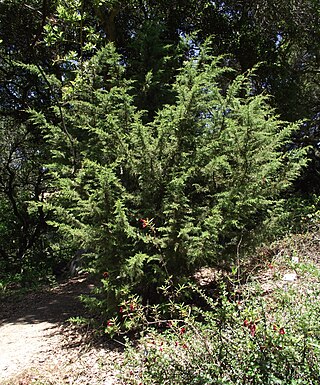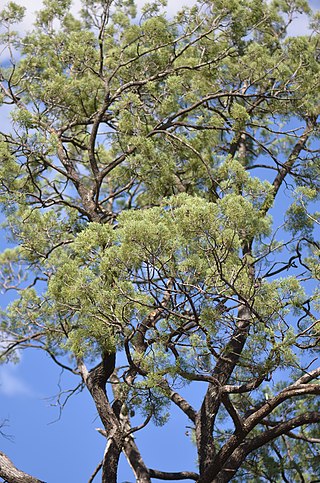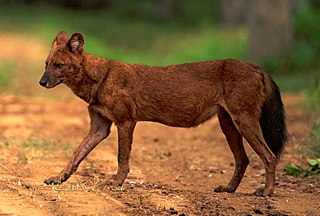
The International Union for Conservation of Nature (IUCN) Red List of Threatened Species, also known as the IUCN Red List or Red Data Book, founded in 1964, is an inventory of the global conservation status and extinction risk of biological species. A series of Regional Red Lists, which assess the risk of extinction to species within a political management unit, are also produced by countries and organizations.

Podocarpus totara (; the tōtara is a species of podocarp tree endemic to New Zealand. It grows throughout the North Island, South Island and rarely on Stewart Island / Rakiura in lowland, montane and lower subalpine forest at elevations of up to 600 m.

Syzygium cumini, commonly known as Malabar plum, Java plum, black plum, jamun, jaman, jambul, or jambolan, is an evergreen tropical tree in the flowering plant family Myrtaceae, and favored for its fruit, timber, and ornamental value. It is native to the Indian subcontinent and Southeast Asia, including Myanmar, Sri Lanka, Bangladesh and the Andaman Islands. It can reach heights of up to 30 metres (98 ft) and can live more than 100 years. A rapidly growing plant, it is considered an invasive species in many world regions.

Hesperocyparis goveniana commonly known as Californian cypress and Gowen cypress, is a species of western cypress that is endemic to a small area of coastal California near Monterey. It was formerly classified as Cupressus goveniana.

The spade-toothed whale is the rarest species of beaked whale. Most specimens found have been in the South Pacific, mostly in New Zealand, but they have also been found in Chile. It is a species of which there is very little known.

Callitris columellaris is a species of coniferous tree in the family Cupressaceae, native to most of Australia. Common names include white cypress, white cypress-pine, Murray River cypress-pine, Bribie Island pine and northern cypress-pine. Callitris columellaris has become naturalised in Hawaii and in southern Florida.

Adenium obesum, more commonly known as a desert rose, is a poisonous species of flowering plant belonging to the tribe Nerieae of the subfamily Apocynoideae of the dogbane family, Apocynaceae. It is native to the Sahel regions south of the Sahara, tropical and subtropical eastern and southern Africa, as well as the Arabian Peninsula. Other names for the flower include Sabi star, kudu, mock azalea, and impala lily. Adenium obesum is a popular houseplant and bonsai in temperate regions.
Panicum socotranum is a species of grass in the family Poaceae.

Hypericum socotranum is a species of flowering plant in the Hypericaceae family which is endemic to the island of Socotra in Yemen. Its natural habitats are subtropical or tropical dry forests and rocky areas.
Teucrium socotranum is a species of flowering plant in the family Lamiaceae. It is found only in the Socotra Islands, part of the nation of Yemen. Its natural habitat is rocky areas.
Erythroxylum socotranum is a species of plant. It is a part of the Erythroxylaceae family. It is endemic to Yemen. Its natural habitat is rocky areas and is threatened by habitat loss.

Exacum affine, known commercially as the Persian violet, is a species of plant in the family Gentianaceae. It is endemic to Socotra, part of Yemen, though its popularity and cultivation around the world have made it an occasional greenhouse weed. Its natural habitat is rocky areas. This is a small herbaceous biennial plant with dark green, ovate leaves. The small purple flowers have a yellow centre with fragrance.

Exacum is a genus of plant in family Gentianaceae. It contains 75 species native to tropical regions of sub-Saharan Africa, southern Arabian Peninsula, south and southeast Asia, New Guinea, and Australia.
Exacum caeruleum is a species of plant in the Gentianaceae family. It is an annual endemic to the island of Socotra in Yemen. Its natural habitat is dense shrubland in the Hajhir Mountains from 900 to 1,250 meters elevation. .
Heliotropium socotranum is a species of plant in the family Boraginaceae. It is endemic to the island of Socotra. Its natural habitats are subtropical or tropical dry forests and subtropical or tropical dry shrubland.
Mesogyne insignis is a species of flowering plants in the family Moraceae. It is the sole species in genus Mesogyne. It is a tree native to the island of São Tomé in the Gulf of Guinea and to eastern Tanzania.

Cynanchum socotranum, synonym Sarcostemma socotranum, is a species of plant in the family Apocynaceae. It is endemic to Socotra Island, south of Yemen. Its natural habitat is subtropical or tropical dry shrubland.

An endangered species is a species that is very likely to become extinct in the near future, either worldwide or in a particular political jurisdiction. Endangered species may be at risk due to factors such as habitat loss, poaching, invasive species, and climate change. The International Union for Conservation of Nature (IUCN) Red List lists the global conservation status of many species, and various other agencies assess the status of species within particular areas. Many nations have laws that protect conservation-reliant species which, for example, forbid hunting, restrict land development, or create protected areas. Some endangered species are the target of extensive conservation efforts such as captive breeding and habitat restoration.

Tabernaemontana pandacaqui, known as windmill bush and banana bush, is a species of plant in the dogbane family Apocynaceae.
Plumbago socotrana is a small shrub growing up to 2m tall, rather glaucous and covered in white mealy powder. It has yellow flowers.













